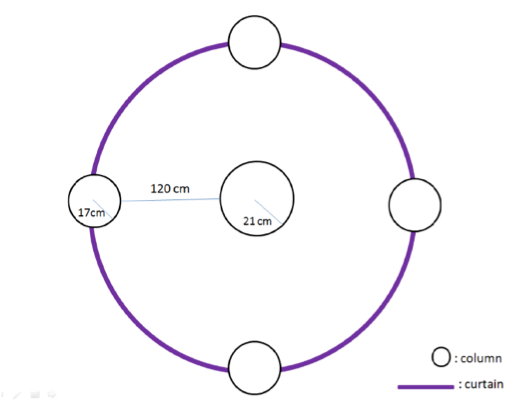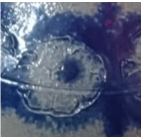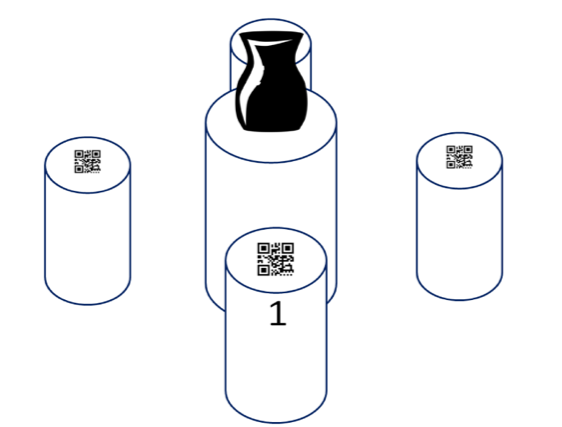filmix
art project
Composed of 2 videos, 2 photographs and a ready-made object, this installation primarily plays with the dialectic relationship between the real and the image. The videos and the photographs surrounding the object convey an experimental narrative between fiction and non-fiction. With altering and enhancing the real journey of the ceramic water jug the medias’ narrative aims to stand in the line between believable/truth and unbelievable/mythical. The spectator is exposed both to the image of the object presented with a narrative through videos and photographs and to the reality of the object itself. The shorter white columns, each containing a QR code, surround the bigger column on the middle which the object stands on. The curtain between the columns on the periphery prevents the spectator to get closer to and fully experience the object with all senses.

The structure and arrangement of the installation mimics the symbols on the water jug. It also reminds orbits and ancient temples which goes along with the mythical theme of the project.


The spectator is always active while experiencing the installation. First, they move to the first column and scan the QR code with their phones. After watching the video, they proceed to the next column. This movement of the spectators are directed with numbers on each column. Keeping the audience active during the experience aims to keep them focused on the installation.

The columns are designed for being visible in the crowd of the exhibition space but invisible in the inertia of the object. They are white to pop up in the dark colored exhibition space from a far. White also enables the spectator to concentrate on the object when experiencing the installation without getting distracted by anything else. The heavy velvet curtain frames the object, drawing the attention to it and preventing anyone from getting closer, thus it adds to the sublime feeling of the object. The indigo color of the curtains mimic the color of the symbols on the jug and creates the same shape in a different dimension. The height difference of the columns are choosen to prevent the object from getting lost in the middle of columns and curtains.
The firs QR code directs the viewer onto a video. This video tells the myth of the object. The myth talks about a ceramic water jug which brings death onto its possessor. The second QR code is for another video which is a testimonial of the actual person that gave us this ceramic water jug. He tells how this jug was gifted to him and how he gifted it to us. The third and forth QR codes are for photographs of us, separately with the jug. The video medium is specifically chosen for the first two steps because the first two steps tell a narrative which runs though time, the life journey of the jug. Last two steps are photographs because they project a frozen moment in time: the fact that two people are currently in possession of that told object. Presenting the visual media via QR code challenges the spectator to be active in the process of getting information. They have control over when to start, pause or rewind watching the video. This labour for information also aims to evoke a game-like feeling in the audience which both creates more engagement in the installation and more interest in the videos since they gave effort to watch it. Also experiencing media via their personal screen which everyone uses in daily basis the artwork occupies a more personal space in the spectator, just as the object and the story reflect personal stories and photographs of the artists. Moreover the visual structure of the QR code again reflects the ancient symbolic way communication via primitive symbols.
The mythical theme as death aims to communicate with the audience on a personal level. Stemming from Dr. Irvin Yalom’s idea of death anxiety, the project tries to find a common ground which everyone can engage in. The ceramic jug reminds both the ancient cremation urns associated with death and ancient water jugs associated with life. The irony of these two connotations goes along with the irony of death coming as a gift.
The project connects with the main theme of the exhibition on different levels. The primary meaning of the phrase “Öteberi” is present in the object itself. The exhibited object is a ready-made object which contrasts with the sublime idea of “objet d’art”, moreover it is found at a thrift-shop which further devalues it. However the narrative re-gives the sublime aura to the object which questions whether the value of an “objet d’art” is present within the object itself or if it is created in the minds of the spectator by the narrative. This sublime aura of the object also connects with “Öteberi” on a different meaning. “Öteberi” can be deconstructed as “öte” and “beri”: Öte; as sublime, image, surreal, fictional and Beri; as daily, reel, real, non-fictional. The position of the object is also “öte” to the spectator as well as the truth of the story. The audience decides for themselves whether the story they’ve been told is “beri” to them as they believe in it, or if it is “öte” to them as they don’t.
BUDGET:
| Material | Quanta | Estimated value |
| Styrofoam | 170x50x50 cm | 30 TL |
| Styrofoam | 140x40x40 cm x4 | 20 TL x4 |
| Velvet Curtain | 140x924 cm | 400 TL |
| Ceramic Water Jug | 0 TL | |
| QR Code Stickers | 35x35 cm x4 | 7 TL x4 |
| White Spray Paint | x5 | 5 TL x5 |
TOTAL: 563 TL